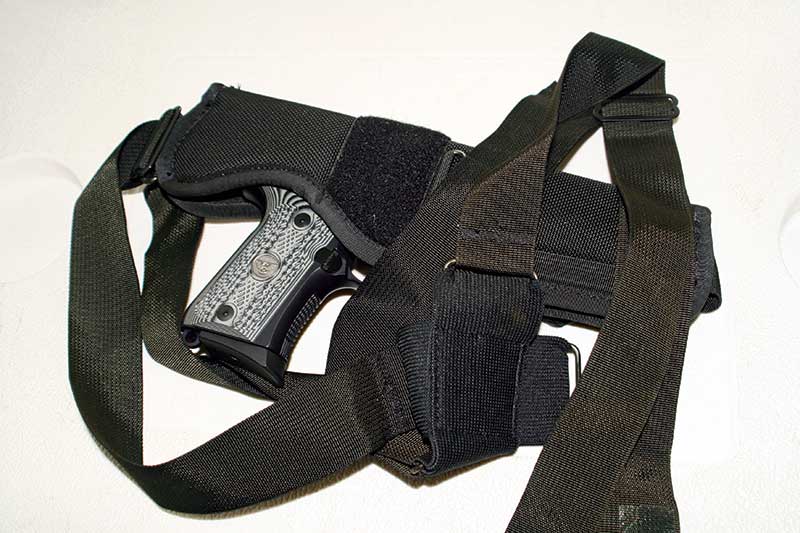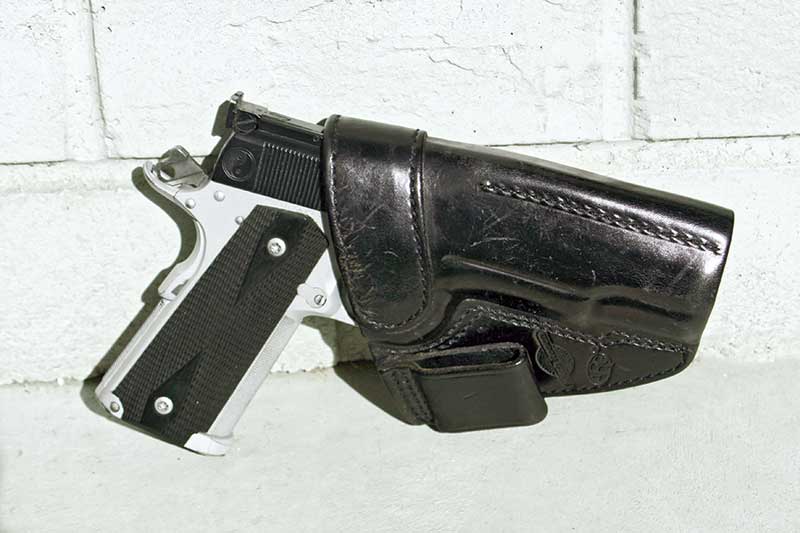Confident Carry
Is Nylon, Traditional Leather,
Plastic Or Kydex The Best
For Concealed Carry?
The Answer Is, “Well…”
For us old farts, the “traditional” element of leather means a lot, all the way down to the smell of it. Bad news: sometimes it needs a touch of oil to keep it from creaking or squeaking. Mold develops on it if it’s stored improperly. It can shrink, and it can stretch, both of which obviously can cause fitting problems at various times in the holster’s life.
Leather holsters often require a break-in period. One premier maker made his holsters so tight, gunwriter Dean Spear nicknamed the guy “Snug.” That said, though, the man’s holsters then and now, once properly broken in, are incredibly long lasting, fast, and secure. The Mitch Rosen Extraordinary Gunleather ARG (Ayoob Rear Guard originally, American Rear Guard since shortly after 9/11) that I designed in the 1990’s is still my favorite inside the waistband holster. Mine, of course, have long since been broken in.
Ah, but the good news! A well-fitted leather scabbard is still very fast, and properly designed (with rigid leather, or a metal-reinforced holster mouth) amenable to 1-handed holstering by feel, an important tactical skill. A proper leather holster allows a silent, surreptitious draw, which can be a lifesaver in certain hairy self-defense situations where you don’t want to show your cards before you lay them down on the table. By the same token, it allows a silent re-holstering if that scary situation has turned out to be a false alarm. Many plastic holsters “announce themselves” with scraping, clicking sounds. And, did I mention a cool sense of tradition?
Plastic Fantastic
Composition material holsters, usually made of Kydex, not only rule all of the action pistol games, but are absolutely huge in the concealed carry market today. They’re cheaper to make, and therefore to sell, than the finest of leather handgun scabbards. Molded more tightly to the guns than leather generally can be, they’re also as a rule more secure in extreme exertion situations like, oh, fighting for your life, assuming an open-top design with no safety straps or other retention devices. No break-in per se is required. They are much easier to clean when you’ve been rolling in dirt or mud. A wet paper towel and maybe some rubbing alcohol are all you need.
Downside: Kydex is noisy. The first of the plastic holsters, long ago when I was young, was a breakfront called the Snick, aptly named for the sound it made when the gun broke clear. The Snick is long gone, but the “snick” remains in the sound made when the gun is drawn or holstered. There goes our “surreptitious draw and re-holster” factor discussed earlier.
Less expensive non-Kydex plastic holsters are certainly serviceable. GLOCK’s own “Sport/Combat” holster is a “best buy” in this category, concealing well and allowing a fast enough draw to win me local pistol matches with it. It’s also ambidextrous. Downside: its thin plastic belt loops give a tenuous hold if an amped-up opponent is trying to pull your holstered gun off your body, and it’s not what I wear when teaching handgun retention classes.
Friendly Fabric
Fabric holsters, usually strong nylon, are popular “entry level” scabbards because of their low price. Unfortunately, their usual “one size fits all” cut generally means they don’t fit any specific gun perfectly. As a rule, both inside- and outside-the-waistband concealment holsters made of nylon aren’t rigid enough for 1-handed reholstering, and even the ones that don’t slip out of your waistband or hang blatantly off your belt often require two hands (or a shoe-horn) to get the darn gun back in there.
Where nylon shines is in shoulder harnesses and belts. For shoulder rigs, I never found a more comfortable harness than the nylon Bianchi Tuxedo. Nylon concealed carry gun belts such as the Wilderness Instructor are hugely popular. In everyday life and teaching, I wear one more than any other kind. In law enforcement, my travels around the country show me at least half of our uniformed cops are now wearing nylon duty belts instead of the traditional leather Sam Browne. In 2005, when my department changed pistols, we chose Safariland for the holsters (as we had before), and Blackhawk! nylon duty gear for belt, mag pouches, handcuff cases, nitrile glove pouch, etc.
The lighter weight greatly improved comfort factor, and they’ve stood up amazingly well. When we went to new guns (and holsters to fit them) this year, we saw no need for replacement since they still looked new and worked fine after a decade of daily wear. We only needed new Blackhawk! mag pouches for the fatter S&W M&P .45 magazines that replaced our previous single stacks.
One huge advantage of nylon for police (and for civilians who lead adventurous lives) is in a world where we get puked on, bled on and have to worry about blood-borne pathogens, it’s a nightmare to get that stuff out of leather once it seeps in. Nylon can just be thrown into washing machines or sprayed down a 10 percent bleach solution, which won’t affect the color of the nylon. Kydex holsters, of course, can be sprayed down with 3M’s HB Quat or a 10 percent bleach solution, but I don’t know of any solid Kydex belts.





